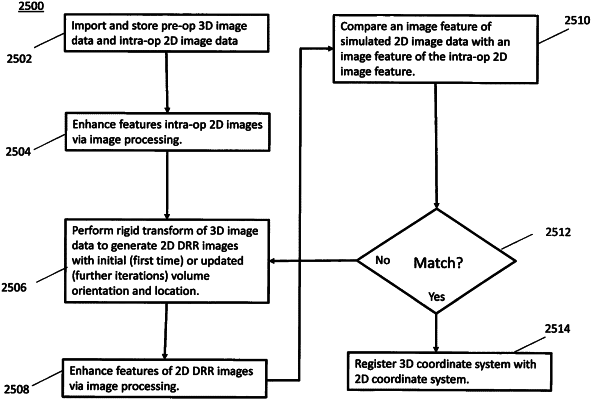| CPC A61B 90/39 (2016.02) [A61B 5/064 (2013.01); A61B 34/20 (2016.02); A61B 34/30 (2016.02); A61B 90/361 (2016.02); A61B 90/96 (2016.02); A61B 90/98 (2016.02); G06T 7/30 (2017.01); A61B 17/17 (2013.01); A61B 90/11 (2016.02); A61B 2017/00876 (2013.01); A61B 2034/2051 (2016.02); A61B 2034/2055 (2016.02); A61B 2034/2057 (2016.02); A61B 2034/2065 (2016.02); A61B 2034/2072 (2016.02); A61B 2090/034 (2016.02); A61B 2090/0811 (2016.02); A61B 2090/3937 (2016.02); A61B 2090/3945 (2016.02); G06T 2207/10004 (2013.01); G06T 2207/10012 (2013.01); G06T 2207/10081 (2013.01); G06T 2207/10088 (2013.01); G06T 2207/30204 (2013.01)] | 14 Claims |

|
1. A surgical robot system comprising: a robot having a robot arm, a robot base and an image registration facility configured to receive a pre-op three-dimensional (3D) medical image of a patient and intra-op two-dimensional (2D) medical image of the patient; and
at least one camera configured to detect one or more tracking markers in an anatomical coordinate system;
wherein the image registration facility is configured to generate a simulated 2D digital medical image from the 3D medical image and perform a 2D-3D registration by matching the simulated 2D digital medical image to the received 2D medical image, wherein the image registration facility initially associates the simulated 2D digital medical image to the received 2D medical image as a starting point of the 2D-3D registration by corresponding a first digital medical object placed on the 3D medical image by a user with a second digital medical object placed on the received 2D medical image by the user,
wherein the position of the robot arm and a position of the patient, using the one or more tracking markers, in the anatomical coordinate system are represented on a display,
wherein the robot arm is coupled to an end effector, the end effector being configured with one or more tracking markers on the surface of the end effector to be monitored when the end effector is translated and rotated in the surgical field.
|